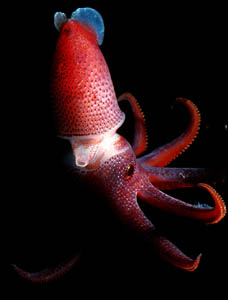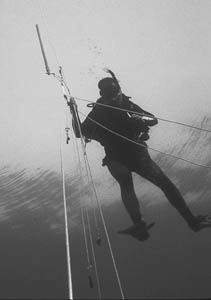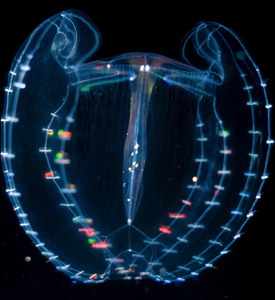![[Metroactive News&Issues]](/gifs/news468.gif)
[ Santa Cruz | Metroactive Home | Archives ]
They Blinded Me With Science
Right under our noses, the neon creatures in Monterey Bay are revolutionizing technology and medicine. Sound crazy? You haven't even met the glowing green bunny yet ...
By Christa Shannon Fraser
IT WON'T BE LONG before we all have a little bit of jellyfish in us. Well, in our pockets, anyway. The next wave in flat panel displays for things like cell phones, watches, computer screens and car dashboards will likely be Organic Light-Emitting Diodes (OLEDs), which are basically powered by living proteins from the ever-unpopular beach stingers and others like it that are fast becoming scientists' new favorite breed of sea beasties.
Why? Because they glow.
With one of the biggest ocean labs right in our backyard in the form of the Monterey Bay Sanctuary, local scientists in particular are finding new discoveries around these bioluminescent creatures quite illuminating.
Those of us whose grasp of marine biology falls somewhere between absolutely nothing and the occasional petting of manta rays at the Monterey Bay Aquarium can't help but find some of this research downright bizarre on the face of it. Household pets are glowing in the dark, Jedi-like organic lasers are on the horizon and scientists are already harnessing the natural light of sea life in the search for breakthroughs in genetic and cancer research.
At this center of all this bright new buzz are two natural phenomena: green fluorescent protein (GFP)--a sturdy, three-dimensional protein that fluoresces under certain lights--and bioluminescence, the chemical process which causes animals to create their own light. While most people don't know much if anything about them yet, they're already changing the face of science in much the same way that lasers did years ago, and they're likely to change our lives in ways even our top brainiacs can barely yet understand.
And they're found, ironically, in a place that we usually think of as almost completely dark. When it comes to the weird world of bioluminescent beasts, it's the ocean's "midwater zone"--below 2,000 feet--that things really start to get interesting.
By the time you get that deep, says Dr. Steven Haddock, bioluminescence scientist at Monterey Bay Aquarium Research Institute (MBARI), it's quicker to list what's not bioluminescent than what is.
Know Your Glow: Five quick facts about glowing sea life.
The Shining Path: Three scientists who saw the light.
Your Chance to Shine
Bioluminescence has been witnessed countless times, and every other seafarer has a story about its enchanting effects. Mariners in the Indian Ocean have reported that at times the entire nighttime sea glows white. This is hardly surprising when you consider that nearly every kind of creature in the ocean lights up: species of dinoflagellates (which are responsible for most of the large light blooms), jellyfish, bacteria, crustaceans, fish and even some species of shark. But while many people have seen these organic lights, it wasn't until this last century that anyone stopped thinking "creepy magic fish" and started thinking science.
How far we've come--so far, in fact, that you may be next. Not ready to glow? Well, how about your pet? Next time Mr. Chuckles makes a break for it, he'll be a lot easier to track if he's lit up like Alba the GFP Bunny, a creation of "bioartist" Eduardo Kac. Alba looks like any other albino bunny, except that she glows green when placed under special lights. She was created using Aequorea victoria GFP.
Alba has been controversial, to say the least, as a piece of living artwork, but the truth is that scores of laboratory animals have been engineered with GFP for experimental purposes. As Kac explains, the GFP Bunny is not some kind of "playing God" via genetic experimentation. Green fluorescent protein has already been successfully expressed in many host organisms, including mammals, and there are no mutagenic effects. In other words, the bunny is not harmed.
But wait, it gets even better: Not only is GFP nontoxic, but because it can easily be attached to genes, it is useful in genetic research, as well. It can be cloned and used with nearly every type of cell in any animal and many plants. Will parents need to buy their kids Nikes with red LEDs when they can simply bioengineer their progeny to blink like a firefly?
Furthermore, GFP negates the need to destroy lab animals to see the results of an experiment. Instead, geneticists can use special light-sensitive cameras to see when a gene is activated in its host organism.
They can also use bioluminescence for gene research by transferring the gene for the enzyme luciferase into the host animal. They follow that with an injection of the chemical luciferin--the interaction between the luciferin and luciferase generates the light. When the light "turns on" in an experiment, researchers know that the gene they are looking at has been activated.
If it's hard to understand the practical value of this whole process, consider how it allows diseases like cystic fibrosis, AIDS and cancer to be studied in greater detail at a molecular level. A.A. Szalay, a doctor and researcher at Loma Linda University in Southern California, writes, "With the aid of a sensitive camera connected to a microscope, even individual cells can be localized in vivo based on light emission--in real time." In other words, researchers don't need to wait for a dissection to see what took place in a lab animal--they can watch it happen. The implications for the future of medicine--and the speed with which we get there--are mind-boggling.
In a post-Hot Zone, highly germ-conscious world, this new glow science is also changing how we test for harmful bacteria in food, bodily fluids and drinking water. In the past, a culture was grown to determine the presence of a virus or bacteria. Now, a flash of light can tell all about the level and type of contamination.
They'll Light Up Our Lives
OLEDs are the high-tech stepchildren of natural bioluminescence. They're created by first removing the barrel around a fluorescent protein. When the exposed molecule is placed in a matrix, such as a polymer, and bathed in electricity, it lights up. Because many stripped down molecules can be compacted into a small area, OLEDs can be made to be very thin.
They can also have a higher contrast than traditional Light Emitting Diodes (LED), such as those now used by a cell phone or digital clock. Furthermore, they can be viewed from any angle without losing clarity.
The possibilities for OLEDs are pushing technology to levels previously imagined only in Bond flicks. They could be used on foldable or rollable sheets of polymers or thin foils as well as panes of clear material--imagine unfurling a computer screen or a digital version of your daily newspaper out of a superlightweight roll that fits in a pocket. Eventually, it will be possible to have full color, high-resolution effects from OLEDs.
Spinoffs of GFP and bioluminescence have already hit the marketplace--in the form of novelty items. A company called Prolume is marketing Biotoys like squirt guns that shoot luminescent water and glowing "Alien Rocks" under the motto "toys and games with a glowing appeal." They plan to put a glowing ink on the market soon.
Dr. Bruce Bryan, co-founder of Prolume, calls this "genetic entertainment," but interestingly enough Prolume is utilizing the novelty potentials of bioluminescence and GFP to help fund future research for medical applications like early cancer detection and bacterial contamination.
The High Cost of Light
Just the collection of bioluminescent and fluorescent specimens from the deep sea costs upwards of $10,000 a day, but there's a possible profit to be made for those who can score a unique patent. What that means for the rest of us, though, is that using GFP and the chemicals that cause bioluminescence is costly and that those who hold the patents for the fluorescent proteins, luciferins and luciferases control the future applications of organic light. That has scientists looking to clone new forms of GFPs and uncover new light-emitting chemicals and proteins.
Haddock is one scientist on that quest. "I would like to clone proteins from the different groups of organisms which have calcium-activated photoproteins (i.e., jellyfish, comb jellies, and radiolarians)," he says. "Not only would this give us more tools for applications of luminescence [with different spectral and kinetic properties], but it would help answer questions about the evolutionary origins of bioluminescence."
On board MBARI's research vessel, Western Flyer, Haddock and other researchers are able to view deep sea creatures in their natural environment at depths as great as 10,000 feet from the comfort of a control room. While they sometimes descend themselves in submersibles, most filming and collection of organisms is done from a remote-operated vehicle, or ROV. The ROV is manned from a control room on board the ship.
Even from the control room thousands of feet above the tethered ROV, the effect of watching an incredible storm of countless strange organisms drifting past hasn't changed since the early part of the 20th century, when pioneering deep sea explorer William Beebe wrote of bioluminescence: "My eyes were weary with the flashing of eternal lights, each of which had to be watched so carefully."
In the 21st century, they're being watched more closely than ever.
[ Santa Cruz | Metroactive Central | Archives ]
Copyright © Metro Publishing Inc. Maintained by Boulevards New Media.
![]()

![[line]](/gifs/line.gif)
![[line]](/gifs/line.gif)
 Go Deep: Scientists at the Monterey Bay Aquarium Research Institute are at the forefront of glow science.
Go Deep: Scientists at the Monterey Bay Aquarium Research Institute are at the forefront of glow science.

From the May 29-June 5, 2002 issue of Metro Santa Cruz.